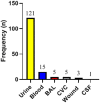Candida africana and Candida dubliniensis as causes of pediatric candiduria: A study using HWP1 gene size polymorphism
- PMID: 33134744
- PMCID: PMC7595836
- DOI: 10.3934/microbiol.2020017
Candida africana and Candida dubliniensis as causes of pediatric candiduria: A study using HWP1 gene size polymorphism
Abstract
Background: Candida species cause a wide spectrum of disease entities. Candida africana and Candida dubliniensis-members of Candida albicans complex-are currently gaining both clinical and epidemiologic significance.
Materials and methods: Totally, 150 pediatric isolates that had previously been identified as C. albicans species complex based on a positive germ tube test were included. The isolates were cultured on CHROMagar Candida medium to ensure their purity and the results of germ tube test. For definitive speciation, PCR amplification and size polymorphism of the hyphal wall protein 1 (HWP1) gene was used. The results of HWP1-PCR were confirmed by sequencing the amplified fragments for randomly selected isolates of C. africana and C. dubliniensis.
Results: All 150 isolates included in this study were reconfirmed as C. albicans complex on chromogenic media. Based on the HWP1 gene size polymorphism, 141 (94%) isolates were identified as C. albicans, 2 (1.33%) as C. africana, and 1 (0.67%) as C. dubliniensis. The remaining 6 (4%) C. albicans complex isolates were a mix of C. albicans and C. africana. All isolates of C. africana and C. dubliniensis have been recovered from cases of candiduria.
Conclusion: C. africana, either alone or mixed with C. albicans, could be a cause of candiduria among pediatric patients and should not be ignored.
Keywords: Candida africana; Candida albicans complex; Candida dubliniensis; Candiduria; pediatrics.
© 2020 the Author(s), licensee AIMS Press.
Conflict of interest statement
Conflict of interest: All authors declare no conflicts of interest in this paper.
Figures
Similar articles
-
Differentiation of Candida albicans complex species isolated from invasive and non-invasive infections using HWP1 gene size polymorphism.Curr Med Mycol. 2021 Jun;7(2):34-38. doi: 10.18502/cmm.7.2.7034. Curr Med Mycol. 2021. PMID: 35028483 Free PMC article.
-
Lack of Candida africana and Candida dubliniensis in vaginal Candida albicans isolates in Turkey using HWP1 gene polymorphisms.Mycopathologia. 2011 Jul;172(1):73-6. doi: 10.1007/s11046-011-9401-2. Epub 2011 Mar 6. Mycopathologia. 2011. PMID: 21380767
-
Prevalence of Candida africana and Candida dubliniensis, in vulvovaginal candidiasis: First Turkish Candida africana isolates from vulvovaginal candidiasis.J Mycol Med. 2017 Sep;27(3):376-381. doi: 10.1016/j.mycmed.2017.04.106. Epub 2017 Jun 20. J Mycol Med. 2017. PMID: 28641919
-
Candida africana vulvovaginitis: Prevalence and geographical distribution.J Mycol Med. 2020 Sep;30(3):100966. doi: 10.1016/j.mycmed.2020.100966. Epub 2020 Apr 5. J Mycol Med. 2020. PMID: 32317216 Review.
-
Candida dubliniensis, a new fungal pathogen.J Basic Microbiol. 2002;42(3):207-27. doi: 10.1002/1521-4028(200206)42:3<207::AID-JOBM207>3.0.CO;2-C. J Basic Microbiol. 2002. PMID: 12111748 Review.
Cited by
-
A Comprehensive Review of Identification Methods for Pathogenic Yeasts: Challenges and Approaches.Adv Biomed Res. 2023 Jul 25;12:187. doi: 10.4103/abr.abr_375_22. eCollection 2023. Adv Biomed Res. 2023. PMID: 37694259 Free PMC article. Review.
-
Differentiation of Candida albicans complex species isolated from invasive and non-invasive infections using HWP1 gene size polymorphism.Curr Med Mycol. 2021 Jun;7(2):34-38. doi: 10.18502/cmm.7.2.7034. Curr Med Mycol. 2021. PMID: 35028483 Free PMC article.
-
Mechanism and bioinformatics analysis of the effect of berberine-enhanced fluconazole against drug-resistant Candida albicans.BMC Microbiol. 2024 Jun 7;24(1):196. doi: 10.1186/s12866-024-03334-0. BMC Microbiol. 2024. PMID: 38849761 Free PMC article.
-
Comparison of PCR-RFLP with 21-plex PCR and rDNA Sequencing for Identification of Clinical Yeast Isolates.Mycopathologia. 2021 May;186(2):213-220. doi: 10.1007/s11046-020-00522-0. Epub 2021 Jan 4. Mycopathologia. 2021. PMID: 33398667
-
Lack of Candida africana in Ugandan pregnant women: results from a pilot study using MALDI-ToF.BMC Res Notes. 2024 Oct 24;17(1):321. doi: 10.1186/s13104-024-06973-8. BMC Res Notes. 2024. PMID: 39449135 Free PMC article.
References
-
- Charsizadeh A, Mirhendi H, Nikmanesh B, et al. Microbial epidemiology of candidaemia in neonatal and paediatric intensive care units at the Children's Medical Center, Tehran. Mycoses. 2018;61:22–29. - PubMed
-
- Romeo O, Criseo G. First molecular method for discriminating between Candida africana, Candida albicans, and Candida dubliniensis by using hwp1 gene. Diagn Microbiol Infect Dis. 2008;62:230–233. - PubMed
LinkOut - more resources
Full Text Sources
Research Materials

